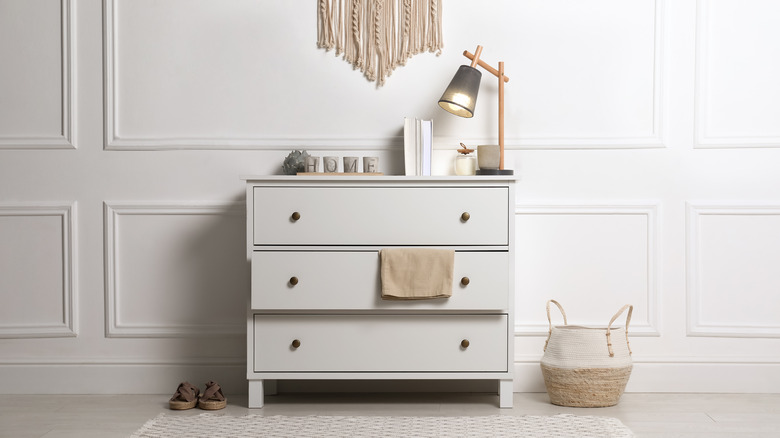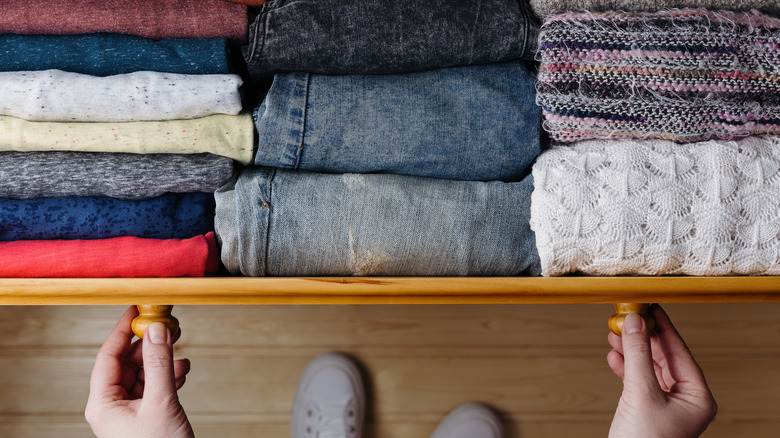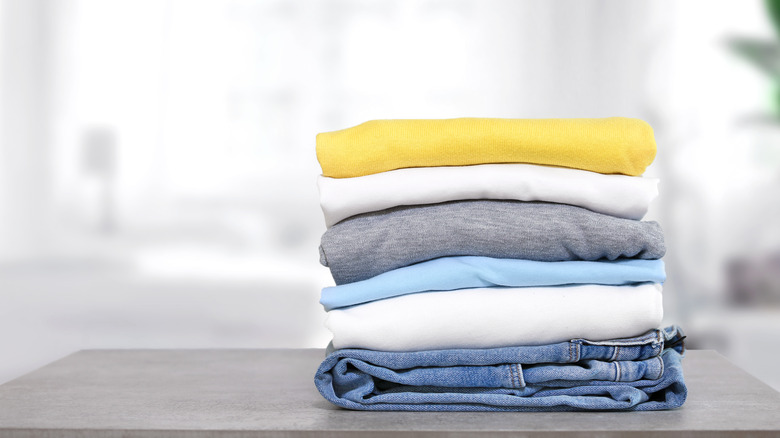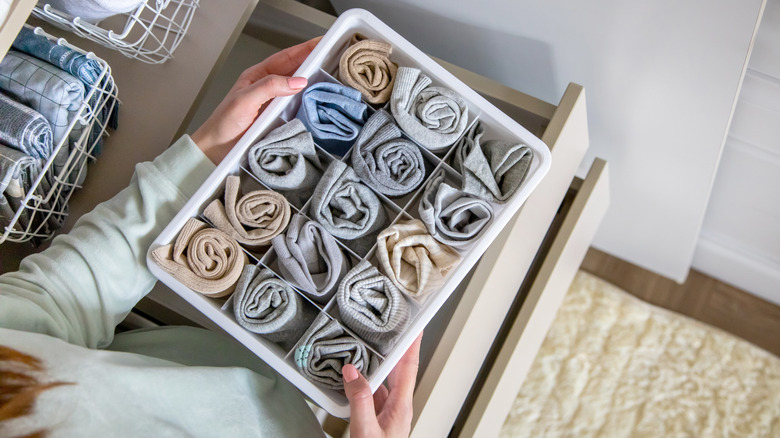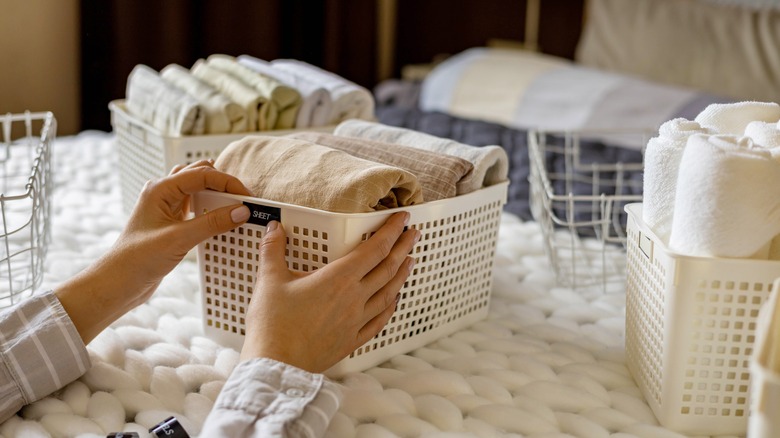An Expert Explains The Best Way To Organize Your Dresser Drawers
Suppose you've decided you're finally going to organize all your clothes, seeking to optimize your morning routine rather than constantly digging through piles of outfits and accessories. In that case, you might be inclined to start with your closet. After all, it's likely where the bulk of your wardrobe is housed, and there are countless budget-friendly ideas for organizing a closet. However, you're also likely storing plenty of your clothing and accessories in your dresser. Plus, since it's easy to slide those dresser drawers shut and hide the contents within, you may find it's even more chaotic and disorganized than your closet is.
Not only will properly organizing your dresser drawers make it much easier to find the pieces you need and see exactly what you have, but it may also give you added storage space. In fact, according to Organized Interiors, using the KonMari Method for folding can provide up to 50% more drawer space for your favorite clothes.
In an exclusive interview with House Digest, Stephanie Y. Deininger, a professional organizer and founder of The Organized Flamingo, shares some great tips for getting those dresser drawers organized once and for all. By prioritizing functionality when organizing, the final result won't just be aesthetically pleasing; it'll make your life much easier.
Factor in frequency of use
Even if you don't have all that much storage space in your dresser drawers, chances are items are lingering within that you don't reach for weekly — or maybe even monthly. Instead, they serve as barriers when looking for the things you need. That's why a piece's frequency of use is an essential factor to consider when organizing. And this also includes how tightly you're wedging items into your dresser.
"Determine how often you will be in and out of the drawers," says Stephanie Y. Deininger. "Dresser drawers that contain everyday items should have a little bit of wiggle room so you can easily take things in and out. When you have to move things around to get something out, or items are tightly stored, it creates an inconvenience."
If you're lucky enough to have adequate storage space and still want to keep those less frequently used items close and easily accessible, make it clear which section contains pieces from that category. "Dresser drawers that only get accessed for seasonal items or special occasions should have some kind of label or way to easily know what is inside the dresser since you don't access it often," Deininger says.
Hone your folding style
For those who are accustomed to shoving their clothing into drawers, folding them first will make a massive difference in the overall appearance of your dresser. However, if you're looking for true organization, you'll want to figure out a folding style that you can use consistently.
"There is no right or wrong way to fold your clothes," Stephanie Y. Deininger says. So don't fear that you must learn the KonMari method and tightly roll everyday items as you might while traveling. Instead, the key is to find what method works for you. "There is also no folding method that guarantees you will stay organized long-term," warns Deininger.
However, she advises not simply figuring out the folding style you prefer — you also need to consider the dresser you're using, as certain folding styles are better suited to specific spaces. "Try different folding methods and pick the one that will work for the dresser space and that you can keep up with," Deininger suggests. "Some drawers are deeper than others or longer in size, so the key is to try a few folding styles and see which one you can keep up with."
Bring in containers
Although finding the right folding style will level up your organization skills, if you're not using containers, you're probably missing out. Why? Because they keep drawers tidy. "Contain the items by using drawer organizers or dividers. This is especially important if you have big drawers where things can move around and get lost," Stephanie Y. Deininger explains. "Having a way to divide the items into smaller sections will create a sturdier way to keep items from mixing and creating a mess inside the drawer."
After all, your drawer will rarely be completely full, with every item in its proper place. Since you'll be using pieces and putting them back, it's easy for stuff to get shuffled around over time. That's right — these organizational tools aren't just about aesthetics; they're practical and can massively help with functionality.
"Containers and dividers also make it easier to access frequently used items and have a home to put them back in," Deininger adds. Simply put, the right container can create a blueprint, so you'll always know where something is supposed to go.
Use labels effectively
Anyone who has ever tackled a big pantry organization project has likely gone through the process of creating labels for food, ingredients, and storage containers. However, have you ever thought of applying that technique to your dresser drawers? According to this expert, it may be incredibly beneficial.
"Label the drawers, especially at the beginning of your organizing journey," Stephanie Y. Deininger explains. "We often create systems that make sense in the moment but then forget what is what and what goes where."
Like dividers, incorporating labels will create almost a blueprint showing where everything needs to go. That way, you'll never forget the genius organization method you worked so hard on. Also, no need to use boring labels; you can create a system that uses colors, cute stickers, or anything you like as long as it helps you remember what each drawer is for.
Are you seeking a clandestine labeling method? Fear not — as Deininger outlines, you can be subtle if that's your preference. "You can create a label that goes outside for easy view or inside it so you can only see it when you open the drawer," Deininger suggests.
Declutter your drawers
There's a reason that many professional organizers suggest starting by decluttering the items you have before creating a long-term organizational system. The more items you have to organize, the more challenging it will be. So, one task to add to your to-do list is taming any clutter in those drawers.
"Schedule declutter sessions every so often. Take everything out and discard the items you don't use and don't want," Stephanie Y. Deininger recommends. This will make your drawers more functional, as you won't waste time looking through items that never leave the drawer in search of the pieces you use every week. And, as a bonus, it'll make it much easier to stick to your organizational system.
"Part of staying organized long-term is going through your stuff often enough to make sure that what you are keeping isn't taking up precious space," Deininger explains.
Find a system that works for you. Perhaps you prefer to do a quick declutter once a month or a quarterly session at the beginning of a new season. The important thing is to have something regularly scheduled before your drawers become cluttered once again.

